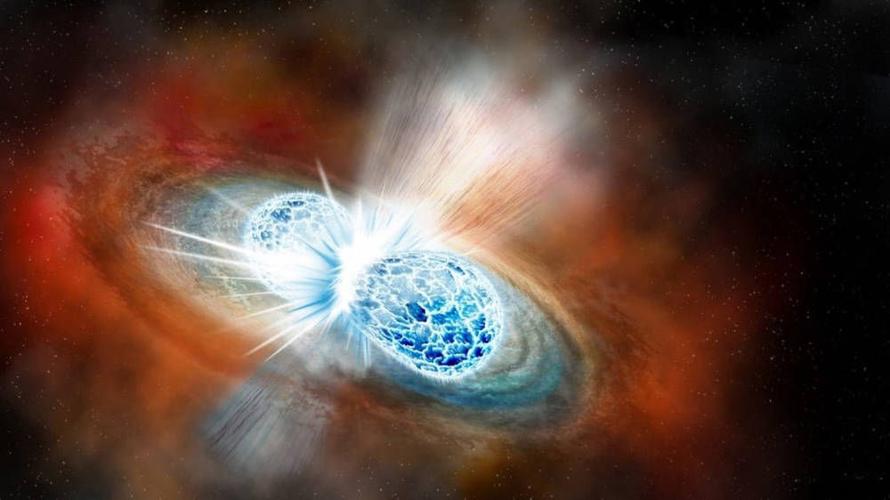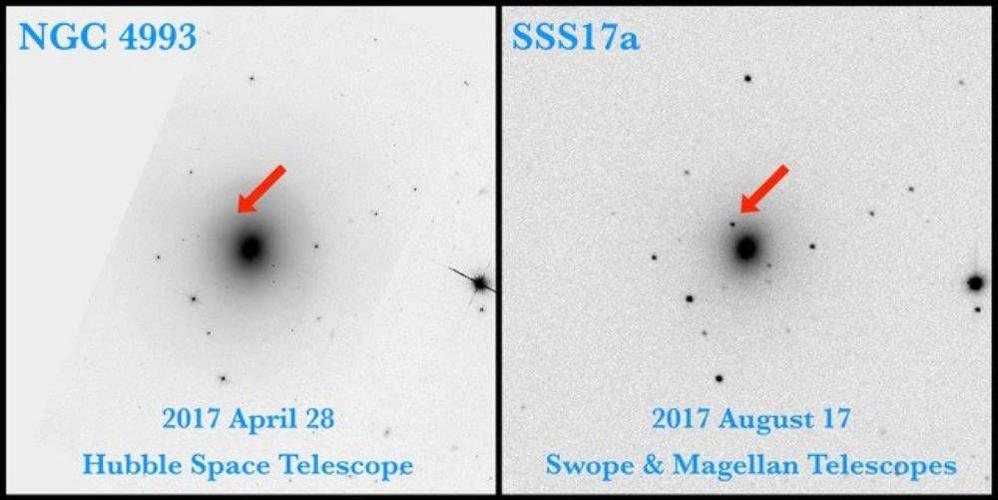Hypernova and kilonova are two astronomical phenomena that produce intense bursts of energy and radiation. A Hypernova is an extremely rare and powerful type of supernova explosion that occurs when a high-mass star collapses under its own gravity.
It releases an immense amount of energy, creating a black hole or a rapidly spinning neutron star. On the other hand, a kilonova is a relatively newer term used to describe the merger of two compact objects, such as neutron stars or black holes.
This collision releases an extraordinary amount of energy, resulting in a bright burst of light and the production of heavy elements in the universe. Both Hypernova and kilonova events are significant in our understanding of the universe’s evolution and the formation of elements. However, they differ in their origins and the processes involved in their formation.

Credit: www.santafenewmexican.com
What Is A Hypernova?
A hypernova and a kilonova are two different astronomical phenomena. While a hypernova is a highly energetic supernova explosion, a kilonova is a result of the merger of two neutron stars. They differ in terms of energy release and the objects involved.
Definition
A Hypernova is an extremely powerful and rare cosmic event that occurs during the death throes of a massive star. It is considered to be one of the most energetic explosions in the universe, surpassing even a supernova in magnitude. These cataclysmic events release an incredible amount of energy, causing the star to explode with an intensity that can outshine an entire galaxy.
Causes Of Hypernova
A Hypernova occurs when a massive star, usually with a mass of at least 30 times that of our Sun, reaches the end of its life. At this stage, the star has burned through its nuclear fuel, causing it to collapse under its own gravity. The intense pressure and temperature in the star’s core triggers a rapid fusion of heavier elements, resulting in a runaway chain reaction.
This fusion of heavier elements creates an enormous amount of energy, causing the outer layers of the star to be violently expelled in a dramatic explosion. The remaining core collapses further, forming a black hole or a highly dense neutron star. This release of energy during a Hypernova is so immense that it can be detected from thousands of light-years away.
Characteristics
A Hypernova is characterized by its extreme brightness and energy output. The explosion can release more than 100 times the energy of a typical supernova. These events emit intense bursts of gamma-ray radiation that are detectable by astronomical instruments on Earth.
The aftermath of a Hypernova can also result in the formation of heavy elements, such as gold and platinum. The intense conditions during a Hypernova allow for the synthesis of these elements, which are then dispersed into the surrounding space, eventually becoming part of new stars, planets, and even life elsewhere in the universe.
Additionally, the gravitational waves generated by a Hypernova can cause ripples in the fabric of space-time, which can be detected by sensitive gravitational wave observatories. These observations provide scientists with valuable insights into the nature of these cosmic events and the properties of the universe itself.
In conclusion, a Hypernova is a rare and powerful cosmic explosion that occurs during the death of a massive star. It is characterized by its extreme brightness, energy output, and the formation of heavy elements. Understanding these awe-inspiring events allows us to comprehend the immense forces at work in the universe and gain a deeper understanding of our place within it.
What Is A Kilonova?
A Kilonova is an astronomical event that occurs when two neutron stars collide or when a neutron star merges with a black hole. It is a rare phenomenon that produces a burst of energy and releases various elements into space.
Definition
A Kilonova can be defined as a powerful explosion that occurs when two super-dense objects, known as neutron stars, come together in a cataclysmic event. This explosion releases an enormous amount of energy, creating a brilliant display of light and heat.
Formation Process
The formation process of a Kilonova starts with two neutron stars that are orbiting each other. Over time, their orbit decays due to the emission of gravitational waves. Eventually, the two stars will spiral closer and closer until they eventually collide.
When the collision occurs, the intense gravitational forces cause the stars to merge. The immense energy released during this process results in a Kilonova. This explosion is incredibly energetic, generating a burst of gamma-ray radiation that can be detected by telescopes.
Properties
A Kilonova is characterized by several unique properties:
- Brightness: Kilonovae are one of the brightest events in the universe, reaching luminosities thousands of times brighter than a typical nova or supernova.
- Color: The light emitted by a Kilonova varies in color, initially appearing blue or purple and later transitioning to red. This change in color is due to the production of heavy elements during the explosion.
- Ejecta: The collision of two neutron stars in a Kilonova results in the ejection of a large amount of matter into space. This matter contains heavy elements, such as gold, platinum, and uranium, which are formed during the explosion.
- Duration: A Kilonova event is relatively short-lived, typically lasting only a few days or weeks. However, the afterglow of the explosion can persist for several months or even years.
In conclusion, a Kilonova is an immensely powerful and visually stunning astronomical event that occurs when neutron stars collide or merge with black holes. Its formation process involves the spiraling orbit and eventual collision of these super-dense objects. Kilonovae are characterized by their incredible brightness, changing colors, ejection of heavy elements, and relatively short duration.
Differences Between Hypernova And Kilonova
Hypernovae and Kilonovae are distinct astronomical events; Hypernovae result from massive star explosions, emitting intense gamma-ray bursts. In contrast, Kilonovae are the merger of neutron stars, generating gravitational waves and heavy element synthesis.
Differences Between Hypernova and KilonovaEnergetic Output
Hypernova releases intensely high energy levels, overpowering a kilonova.
Meanwhile, a kilonova produces lesser energy compared to hypernova events.
Initial Trigger
- Hypernova: Formed from collapsing massive stars after exhausting fuel.
- Kilonova: Arises from neutron star mergers due to gravitational forces.
Outcome
- Hypernova: Results in black hole formation or massive explosion.
- Kilonova: Leads to creation of heavy elements like gold and platinum.
Similarities Between Hypernova And Kilonova
Origin
Both hypernovae and kilonovae are massive cosmic events originating from the deaths of stars. These phenomena occur when a star reaches the end of its life cycle and undergoes a catastrophic collapse, resulting in a powerful explosion that releases an immense amount of energy.
Astronomical Impact
Hypernova and kilonova events have a profound impact on the surrounding space and celestial bodies. The energy released during these events can generate powerful bursts of radiation and gravitational waves, which can be detected by observatories and provide valuable insights into the nature of the universe.
Observational Techniques
Observing and distinguishing between hypernovae and kilonovae involves leveraging a range of advanced tools and techniques. The different observational methods enable scientists to identify and study these cosmic phenomena, shedding light on their unique characteristics and behavior.
Tools Used
The following table outlines the primary tools utilized in the observation of hypernovae and kilonovae:
| Observational Tool | Purpose |
|---|---|
| Telescopes (ground-based and space-based) | Capturing optical, infrared, and ultraviolet emissions |
| X-ray and Gamma-ray Detectors | Detecting high-energy radiation emissions |
| Spectrometers | Analyzing the spectral lines of emitted radiation |
| Gravitational Wave Detectors (e.g., LIGO) | Identifying gravitational wave signatures |
Detecting Hypernovae Vs Kilonovae
The distinction between hypernovae and kilonovae can be achieved through various methods, some of which are highlighted below:
- Observing the duration of the event, as hypernovae typically have shorter durations compared to kilonovae
- Analyzing the emitted radiation across different wavelengths using telescopes and detectors
- Detecting gravitational waves, which are characteristic of certain types of cosmic events
- Studying the spectral features to identify unique signatures associated with each phenomenon
Recent Discoveries And Findings
Recent Discoveries and Findings in the realm of astrophysics have shed light on the differences between Hypernova and Kilonova. Uncovering their distinct characteristics has captivated scientists and enthusiasts alike.
Notable Events
Scientific Contributions
Future Prospects And Research Directions
The study of hypernovae and kilonovae holds tremendous potential for future research and exploration. As we delve deeper into these cosmic phenomena, we uncover more unanswered questions, pushing us to develop new technological advancements and explore exciting research directions.
Unanswered Questions
1. Why do some massive stars undergo hypernova explosions while others experience kilonovae events?
2. What are the specific conditions that trigger these cataclysmic events?
3. How do hypernovae and kilonovae contribute to the formation of heavy elements in the universe?
4. What role do these cosmic explosions play in the evolution of galaxies?
5. Are there different types of hypernovae and kilonovae, each with distinct characteristics and outcomes?
Technological Advancements
Researchers are constantly striving to improve and develop new technologies to advance our understanding of hypernovae and kilonovae. These technological advancements include:
- Advanced telescopes equipped with higher-resolution sensors and detectors
- High-performance computing systems for simulating the complex physics involved
- Space-based observatories for capturing data without the distortion caused by Earth’s atmosphere
Research Directions
1. Observational studies: Continue monitoring and collecting data on hypernovae and kilonovae events across different galaxies and environments to identify patterns and correlations.
2. Theoretical modeling: Develop more accurate and comprehensive theoretical models to simulate the formation and evolution of hypernovae and kilonovae.
3. Elemental analysis: Study the composition of the ejected materials from hypernovae and kilonovae to gain insights into the production of heavy elements like gold, platinum, and uranium.
4. Multi-messenger astronomy: Combine data from different sources, such as gravitational wave detectors and electromagnetic observatories, to obtain a more complete picture of these cosmic events.

Credit: www.tiktok.com

Credit: www.santafenewmexican.com
Frequently Asked Questions On Hypernova Vs Kilonova
What Is The Difference Between Hypernova And Kilonova?
Both Hypernova and Kilonova are powerful astronomical events, but they differ in their causation and resulting phenomena. A Hypernova is the explosion of a massive star, while a Kilonova is the merger of compact objects, such as neutron stars. The energy releases and resulting phenomena also vary between the two events.
How Do Hypernova And Kilonova Events Impact The Universe?
Both Hypernova and Kilonova events have significant impacts on the universe. They release massive amounts of energy, resulting in the creation and distribution of heavy elements. These events also contribute to our understanding of the formation and evolution of celestial bodies, providing valuable insights into the universe’s mechanisms.
Are Hypernova And Kilonova Events Observable From Earth?
Yes, both Hypernova and Kilonova events are observable from Earth using advanced astronomical instruments. Scientists and astronomers actively monitor the sky for these events and study their characteristics to expand our knowledge of the cosmos. Additionally, technological advancements have led to the detection and analysis of these phenomena from various vantage points.
Conclusion
In the cosmic showdown between Hypernova and Kilonova, both phenomena offer unique insights. While Hypernova are massive stellar explosions, Kilonova represent neutron star collisions. Understanding these events enriches our knowledge of the universe’s wonders. Dive deeper into the celestial spectacle of Hypernova versus Kilonova.



